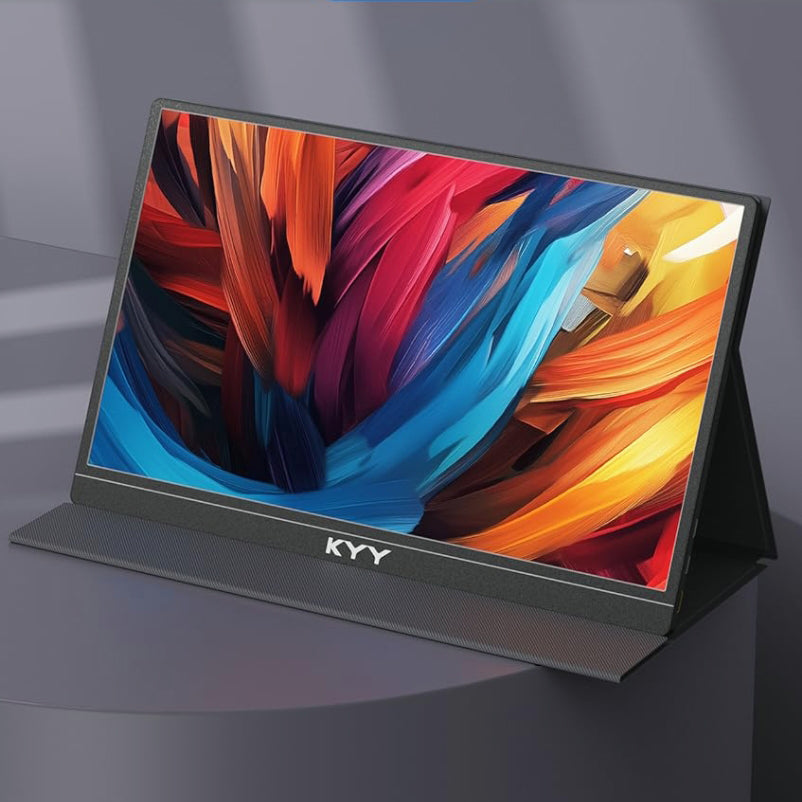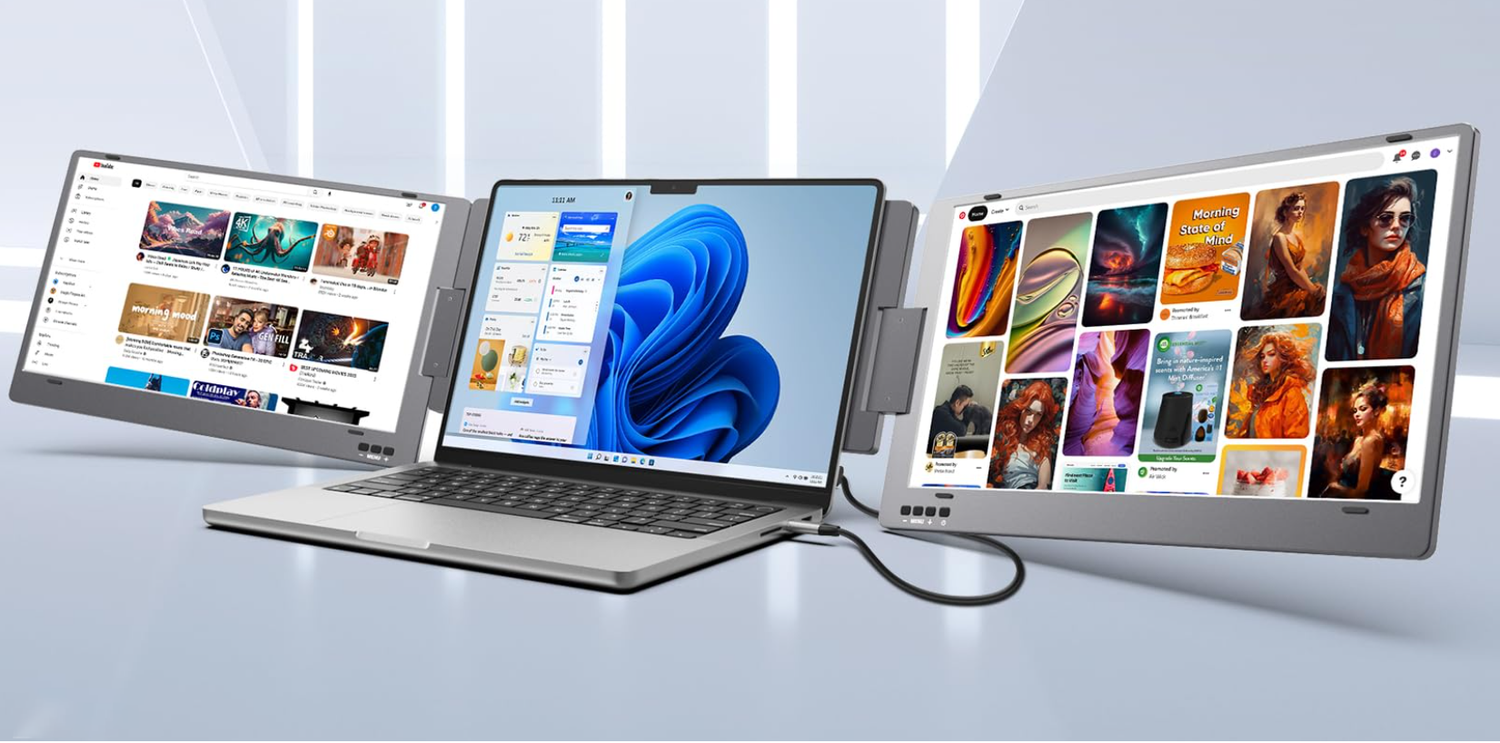In an era dominated by flexibility and mobility, portable monitors are becoming more and more popular. It can improve people's work efficiency, gaming experience and overall convenience. But before buying a portable monitor, many people have one question: Are portable monitors worth it?
What is A Portable Monitor?
A portable monitor is a compact display device that can be easily carried and connected to a variety of devices such as laptops, tablets, and smartphones. Unlike traditional monitors that are fixed to a specific workspace, portable monitors have the flexibility to expand your screen space wherever you are.
How do portable monitors work?
Portable monitors work by connecting to a device such as a laptop, tablet, or smartphone and act as an additional monitor. The connection between a portable display and a device is usually established through a variety of ports, the most common being USB-C, HDMI, or DisplayPort. Here’s how portable monitors commonly work:
Connection:
Portable monitors are equipped with input ports, which may include USB-C, HDMI, DisplayPort, or other ports. These ports allow the display to make a physical connection to the source device.
Power Source:
In many cases, portable monitors draw power from the device to which they are connected. This means they don’t require a separate power source, making them more convenient to use on the go. Some portable monitors also come with their own built-in battery for added flexibility.
Video Signal:
The video signal is transmitted from the source device to the portable monitor through the selected input port. The monitor processes this signal and displays the content on the screen.
Driver Installation:
Depending on the operating system and specific portable monitor model, users may need to install drivers for proper operation. Some portable monitors are plug-and-play, while others require drivers to be installed before they can be used.
Display Settings:
Users can often customize a portable monitor's display settings, such as resolution, orientation, and brightness. This allows for seamless integration of portable displays into existing display setups.
Extended Display or Mirroring:
Portable monitors offer different display modes. The most common are extended displays or mirrored displays. The extended display gives users extra screen real estate, essentially creating a dual-monitor setup. Mirroring, on the other hand, replicates what is on the home screen.
Touch Screen and Other Features:
Some portable displays have touch screen capabilities, allowing users to interact with their devices using touch gestures. Additionally, premium models may include features like built-in speakers, a USB hub, and even support for pen input.
Compatibility:
Portable monitors are designed to be compatible with a variety of devices, including laptops, tablets, and smartphones. Compatibility is usually ensured by using standard video and power connection ports.
Refresh Rate and Response Time:
With portable gaming monitors, factors like refresh rate and response time become important. These specifications impact the quality of the gaming experience by ensuring smoother motion and reduced input lag.
Essentially, portable monitors simplify the process of extending or duplicating a monitor, giving users the extra screen space they need. The flexibility and convenience these devices offer make them popular among professionals, gamers, and anyone who values a portable, versatile display solution.
Pros and Cons of Portable Monitors
Pros:
- Mobility and Flexibility: The main advantage of a portable monitor is its mobility. Whether you're a digital nomad, a frequent traveler, or someone who works from different locations, a portable monitor lets you set up a dual-screen workspace on the go.
- Increased Productivity: For professionals who design, code, video edit, or any task that benefits from multiple monitors, portable monitors can significantly increase productivity. It offers the convenience of a larger workspace without the need for a permanent setup.
- Game on the go: Gamers can take advantage of portable gaming monitors that feature high refresh rates and low response times. This allows for an immersive gaming experience outside the confines of traditional gaming settings.
- Connectivity Versatility: Portable monitors often come with a variety of connectivity options, such as USB-C, HDMI, and DisplayPort. This versatility ensures compatibility with a wide range of devices.
Cons:
- Cost: Quality portable monitors can be relatively expensive. Cost may be a factor for some users, especially if you're on a budget.
- Size and Resolution Limitations: Due to their portability, these monitors tend to be smaller in size than regular desktop monitors. Additionally, some models may have lower resolution, affecting image clarity for certain tasks.
- Power Consumption: Portable monitors often rely on power from the device to which they are connected. If your laptop or other device has limited battery life, it may affect the usability of your portable monitor.
Why Do People Use Portable Monitors, and Who Uses Them?
Professional Use
- Digital Nomad: Individuals who work remotely or travel frequently find portable monitors useful for creating a dual-screen setup on the go.
- Designers and Creators: Graphic designers, video editors, and content creators benefit from additional screen real estate for editing and multitasking.
Game Lovers
Mobile Gamers: Portable gaming monitors cater to gamers who want a high-quality gaming experience without being tied down by a fixed gaming rig.
General Use
- Business professionals: People who regularly attend meetings can use portable monitors to enhance presentations or collaborative work.
- Students: Students can use portable monitors for study, research, and collaborative projects, especially in a group setting.
What Should We See Before Buying a Portable Monitor?
In our fast-paced world, mobility is key and the demand for portable technology continues to grow. Portable monitors have become an important tool for professionals, gamers, and students, providing flexibility and convenience on the go. So, what do you need to consider before considering buying a portable monitor?
1. Size and Resolution:
Start by evaluating the size and resolution of your portable display. Consider your size-related portability needs and choose a resolution that suits your specific use, whether that's work-related tasks, content creation, or gaming.
2. Connection Options:
Check available input ports such as USB-C, HDMI, and DisplayPort. Ensure compatibility with your device and consider the versatility of connectivity options for a seamless user experience.
3. Power Source:
Evaluate portable monitor power supplies. Models can draw power from connected devices or have built-in batteries. Choose according to your usage scenario. Choose according to your usage scenario; a monitor with its own battery can be advantageous when preserving your laptop or device's battery life is crucial.
4. Build Quality and Design:
Check the build quality and design of your portable monitor. The slim and lightweight design is ideal for portability, while the durable construction ensures longevity, even with frequent travel.
5. Total Weight:
Pay special attention to the overall weight of the portable monitor. Every ounce counts, especially when you're moving a lot. Choose a lightweight model that meets your mobile needs without compromising on basic functionality.
6. Display Technology:
Different portable monitors use different display technologies. Depending on your specific requirements, consider factors like IPS panels for superior color reproduction or TN panels for faster response times.
7. Refresh Rate and Response Time:
Gaming enthusiasts should pay attention to the refresh rate and response time of portable monitors. Higher refresh rates ensure smoother gaming visuals, while low response times reduce input lag for a more responsive gaming experience.
8. Touch Screen Function:
Some portable monitors offer touch screen functionality. Evaluate whether touch input is critical to your workflow, or whether you simply prefer the convenience of touch gestures.
9. Adjustability and Mounting Options:
Check out the adjustable stand options or VESA mounting brackets. This flexibility allows you to customize the viewing angles to adapt the monitor to different work environments.
10. Compatibility with Devices:
Make sure the portable monitor is compatible with your device, whether it's a laptop, tablet or smartphone. Compatibility guarantees seamless connectivity and optimal performance.
11. Additional Features:
Consider any additional features a portable monitor might offer, such as built-in speakers, a USB hub, or compatibility with stylus input. These features can add value to your overall user experience.
12. Price and Brand Reputation:
Balance your requirements with your budget, and consider the brand's reputation. Investing in a reliable and well-respected brand ensures customer support and quality products.
All in all, the pursuit of the perfect portable monitor requires careful evaluation of a variety of factors, and whether you're a professional on the go or a gamer looking for a portable setup, it's important to find a portable display that suits your needs.
In Conclusion
The decision to invest in a portable monitor ultimately comes down to personal needs and preferences. For those who prioritize mobility, increased productivity, and versatile use scenarios, a portable monitor can be a valuable addition to their tool kit. While there are some drawbacks, the benefits often outweigh the drawbacks, making portable monitors a worthy consideration for a wide range of users.
In today's fast-paced world, flexibility is crucial, and portable monitors are proof that innovation continues to bridge the gap between traditional workspaces and the dynamic demands of modern lifestyles.



Leave a comment
All comments are moderated before being published.
This site is protected by hCaptcha and the hCaptcha Privacy Policy and Terms of Service apply.